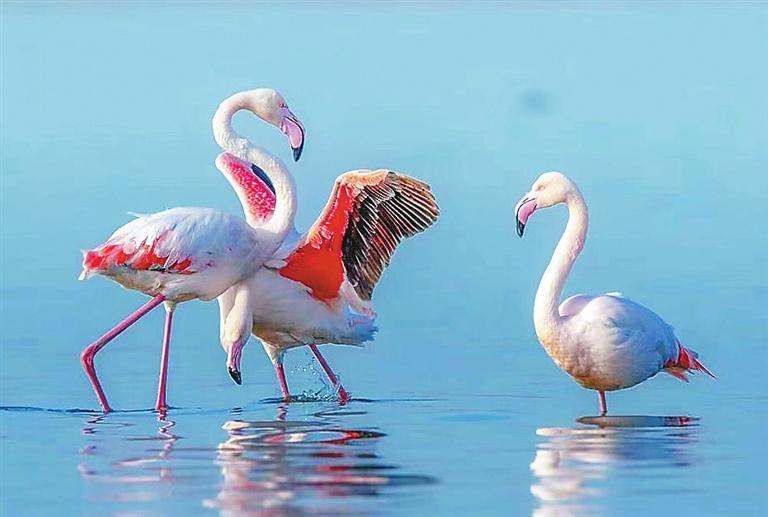
SOMETIMES walking leisurely on the lake, sometimes playing with one another, three flamingos in pink and reddish plumage have attracted dozens of shutterbugs in camouflage coats to a feathery photo shoot at a salt lake in North China’s Shanxi Province. After two days, Li Zhongyou was finally satisfied with a photo of two flamingos cuddling up. In order to get the photo, he traveled more than 1,000 kilometers to the lake in suburban Yuncheng City. Wild flamingos mainly live on large, shallow water like pans and saline lakes in temperate and tropical zones and are found in Africa, Americas and the Mediterranean region, among others. No fixed habitat for the birds had been found in China before 2014. Zhang Weiping, one of the first people to take photos of flamingos in Yuncheng, recalled that in the summer of 2014, he was told that several unrecognizable birds had arrived at the salt lake, and only after arriving at the lake did he recognize them as flamingos. However, some of them had drooping wings, and some were sluggish and did not look in very good condition. “There were enough artemia, which is favored by the flamingos, in the lake, plus people’s protection efforts, so the birds gradually recovered after a few months,” said Zhang, who revealed that the improvement could be seen by looking at the color and brightness of feathers when the flamingos spread their wings. The recovered flamingos left the lake soon after, and it was thought that the “rare visitors” had just stopped by. However, a few months later another batch of flamingos was spotted. Since then, the salt lake has become a stopover site during the flamingos’ annual migration, with the total number of birds reaching as high as eight. Photos of the flamingos in the salt lake went viral online, attracting enthusiastic photographers from across the country. Meanwhile, these shy creatures no longer just remained in the middle of the lake, but started getting closer to people, sometimes moving to just a few dozen meters away from them. “Besides flamingos, another 100 species of wild birds can be spotted here, such as black storks and whooper swans, and the salt lake has become one of the must-visit places for bird photographers in the country,” Zhang said. The reasons why the flamingos first landed in Yuncheng are still unknown, but the significant improvement in the ecology of the lake, which was once a chemical production site, is undoubtedly an important one. The salt lake has seen human activities since ancient times, and its mining history can be traced back to 4,000 years ago. After the 1950s, the development of local chemical enterprises reached a peak, which damaged the surrounding environment of the lake. At one point, there were 15 work sections around the lake that were mining and manufacturing chemicals, with tall chimneys constantly releasing black smoke into the sky. Lyu Guoyu is a photographer who works for a salt lake ecological protection and development center. During his field research, he met many photographers, and under their influence, he fell in love with bird photography. “Talking to them gave me a deeper understanding of ecological protection, which helped make our work more target-oriented,” Lyu said. To better protect the ecology of this salt lake, industrial production activities around the lake were completely terminated in 2020, and restoration work on mountains, forests, and lakes was also carried out. “Birds are the ‘elves’ of the salt lake, and photos can help more people know them, thus calling on everyone to protect our environment,” Lyu said.(Xinhua) | 
